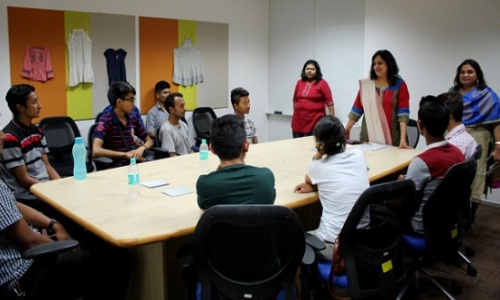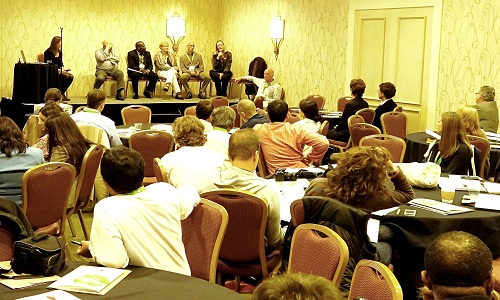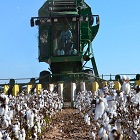FW
Soft and stretch denim fabric was the center of attraction among visitors and buyers at the 5th Bangladesh Denim Expo held in Dhaka on Tuesday and Wednesday. Exhibitors said most of their latest collection was soft and stretch fabric while they also concentrated on sustainability. Visitors were seen roaming every stall, checking the fabric and discussing with the exhibitors at the two day long exhibition.
Foshan Seazon Textile and Garment based in China brought two way stretch and a good number of visitors crowded at their stall. Pervej Mahbub, Marketing Manager in the company’s Bangladesh office said this fabric is more comfortable than other stretch denim and got a good response from buyers.
Taiwan based Yogotex Fabrics exhibited polka dot stretch denim at the exhibition. Tareq B S. Khan, a senior executive at its Bangladesh office pointed out the product got a good response from buyers. Similarly, Foshan Huafeng Textile displayed stretch and soft denim fabric, magic colored denim fabric. Li Miao Qiong, Business Supervisor said they have got good orders at the exhibition. “Buyers like our magic color stretch fabrics.” In fact, exhibitors pointed out that most visitors looked for stretch denim fabric at stalls.
As Jahid Hasan, Marketing Sales Executive of Wong’s Group said most of their latest collection is cotton stretched fabric and they got a good response at the expo. Besides fabric companies, other related companies also put up stalls. Singapore’s business solution company 3D Denim Laser Washing had a stall. And Will Li, Sales Manager said they have got some orders at the exhibition. Sarena Dyeing and Finishing also had a stall and Sultan Ahmed, Manager, was happy with the response from visitors.
Clothing retail giant Primark has joined the European Clothing Action Plan (ECAP). ECAP aims to develop a framework to promote practical action for tackling carbon, water and waste footprints across the lifecycle of clothes. It was launched in May 2016.
Primark is one of five businesses to have signed up to the initiative so far, along with Dutch sustainable sock producer Star Sock, Italian clothing brand OVS, Swedish ski-wear firm Peak Performance, and Spanish children’s clothing producer Bobo Choses.
Primark’s decision to join ECAP comes as part of its commitment to reducing its environmental impact. The firm has been blamed for encouraging fast fashion due to its low prices, but like many high street retailers has also launched a series of initiatives to try and curb its environmental footprint.
The ECAP plan aims to help firms better understand the impact of the fibers used in their clothing ranges and to encourage steps to use more sustainable alternatives, such as choosing a more sustainable cotton over traditional cotton. Overall the initiative aims to help its members collectively divert 90,000 tons of clothing waste from landfill and incineration, reduce their climate impact by 1.6 million tons of Co2, and save 588 million cubic meters of water.
The Indian textile sector is facing challenges especially in the export market mainly due to uneven tariff and non-tariff barriers. It’s hoped GST will bring down input costs, give a boost to textile exports and bring in greater capital investment in the sector.
Many states do not have a dedicated textile minister. A well-coordinated cohesive governance approach will ensure more effective program implementation and sectoral outcomes. India’s positioning in international markets depends upon branding of Indian textile products. Branding of handloom products by involving top designers and retail giants in the country has led to a paradigm shift in the handloom sector. There is a proposal to brand ‘Eri’ silk as peace silk from the land of the Mahatma.
Capacity enhancement in the production of textile machinery in the country would address the challenges of industry such as cost of power and labor. Views and contributions of all states would be reflected in the new textile policy, so that India becomes the textile destination of the world.
The MoU between IGNOU and The National Institute of Open Schooling provides free, anytime, anywhere education to children of weavers and artisans. The Indian textile industry is extremely varied, with hand-spun and hand woven textiles at one end and capital intensive sophisticated mills at the other.
Gujarat is facing a shortfall in cotton supply due to the currency monetisation. From 35,000 bales of cotton, arrivals have dropped to 15,000 bales. Gujarat is a major cotton-producing state.
There are some transaction issues. Ginners can only pay in cheques, but farmers are not interested in payment through cheques. So farmers return home with the cotton. Just about 20 per cent of farmers are open to payment through cheques. Even otherwise, the cotton trade is mainly carried out through cash.
For ginners, procurement of cotton can cost up to at least Rs 3 crores a day. There is a fear farmers may hike prices of the crop if the markets remain shut due to a lack of funds. Business transactions will be low until the situation stabilizes. This is the peak arrival season for the cotton crop.
Till the day before the decision to scrap the currency was taken, markets were operating at peak activity. Arrival of all crops were recorded in normal quantities. But since then market activity has dropped. Cotton seed and cotton oil prices have also risen. Where usually there is movement of Rs 2 or Rs 3 per 20 kg in their prices each day, there has been a movement by nearly Rs 10 per 20 kg since then.
The European Union will sign a textile protocol with Uzbekistan only if it’s satisfied Uzbekistan has made progress in scaling back the use of child labor. The EU wants the practice of forced labor and child labor to be eradicated from the national to the local levels.
Europe represents a major market for Uzbek cotton. In 2013, Uzbekistan began allowing the ILO to monitor the annual harvest. Along with a boycott by major clothing manufacturers, Uzbekistan made progress in scaling back the use of child labor and EU pressure certainly played a part.
ILO said in 2015 the use of children in the cotton harvest in Uzbekistan has become rare, sporadic and socially unacceptable. But there are charges Uzbekistan has simply shifted to a greater use of forced adult labor, continuation of a demanding production quota system, and harassment of independent monitors.
Human rights advocates say entering into the textile protocol with Uzbekistan now would have an adverse impact on human rights. Uzbekistan will soon have a new president and it is yet to be seen whether he will engage in significant reforms in Uzbekistan’s cotton industry. The EU may be hoping that a reward for improvements to date will entice the new leader to consider future reforms.
Zimbabwe's clothing industry continues to deteriorate due to high costs of production, antiquated machinery and the influx of cheap clothing and fabrics. Sustained erosion of incomes has forced Zimbabweans to resort to cheap imports, including second hand clothes.
There are 64 million tons of second hand clothes from overseas waiting to be dumped in Africa. The industry wants a ban on cheap clothing imports, which would cushion it from unfair competition. The textile and clothing subsectors play a major role in Zimbabwe. They provide vital commodities such as shirts, trousers, suits, dresses, hats, stockings, underwear, blankets and towels.
There are concerns revenue officials are working in cahoots with cartels involved in the smuggling of goods into the country. Cotton production has been falling in Zimbabwe over the years, forcing farmers to resort to cash crops. Tumbling cotton prices have made it unattractive in comparison with other cash crops such as tobacco. At its peak in 2012, cotton production by small scale farmers was at 660 million bales.
The period 2000 to 2010 was the most difficult for the textile and clothing sectors. A number of companies closed and a number of people employed by this sector lost their jobs.
An orientation program for NERLP students was held on October 22, 2016. The program was coordinated by business head and project leader, MSPL, Neera Chandra.

It was presided over by Anita Gupta OSD, SICB, Govt. of Sikkim, as the chief guest for the program. The first panel of speakers included Krishan Gaur, head, special projects, NSDC, Harmeet Singh Bedi, senior merchandiser, MEPL, with 25 years of experience, Ginni Gulati, senior operation manager, MEPL, with 20 years of experience, Uday Singh, senior fabric sourcing manager, MEPL, with 20 years of experience.
After a light high tea the second panel of speakers included some eminent people from industry. Animesh Saxena, CEO Neeti Clothing, elaborated and guided students on how to settle in work conditions of Delhi.
Mridula Lall, country manager, India and China, Indisca, spoke about the job role of merchandiser and gave an insight into careers and the scope of growth in fashion merchandising.
Arunav Gogoi, designer, MEPL, with 15 years of experience and a native of Assam, shared his experience about settling in Delhi and guided the students to come out of pre-conceived prejudices and be open to work anywhere in India.
Manuj Nagpal spoke about the domestic fashion business and merchandising. Students were inducted by Deepika Gupta, soft skill trainer, MSPL. This was followed by distribution of study material and special trainee kit bags to students. Vineet Lall, director Modelama Skills, concluded the ceremony by thanking the guest for gracing the occasion and summarizing the useful guidance to the students. The whole event was covered by special apparel magazines, that is, Apparel Online and Fashionating World.
"With sustainability taking centerstage, businesses must rethink on their strategy, supply chain, distribution and transparency. These sentiments were echoed during the 5th Annual Organic Cotton Roundtable (OCRT). Close to 230 thought leaders, farmers, textile and fashion industry executives were a part of this conference. Clear initiatives were focussed on seeds and soils, business models, and consumer engagement as material ways to move the organic sector forward."
With sustainability taking centerstage, businesses must rethink on their strategy, supply chain, distribution and transparency. These sentiments were echoed during the 5th Annual Organic Cotton Roundtable (OCRT). Close to 230 thought leaders, farmers, textile and fashion industry executives were a part of this conference. Clear initiatives were focussed on seeds and soils, business models, and consumer engagement as material ways to move the organic sector forward.
“Organic agriculture with its principles of health, ecology, fairness and care not only reminds us of what really matters but also shines a light on how to get there,” said Liesl Truscott, Director of Fiber & Materials Strategy at Textile Exchange, organisers of the OCRT.

Leo Johnson, Partner in PwC’s Sustainability & Climate Change team, introduced the concept of ‘massive small’, mobilising people’s latent creativity, harnessing the collective power of many small ideas and actions. In his keynote, Johnson talked about progressive economics in an age of climate change and the links between progressive economics and the principles underpinning organic agriculture. He asked, “Can organic cotton change the course of business?”
Bob Bejan, GM-Global Communications Strategy, Microsoft, highlighted, “Through the sharing of stories, we can be inspired and more deeply motivated to solve the big ‘wicked’ questions of our time.” US company, Patagonia, regarded as one of the best adventure tales of our time, is always ready to push the boundaries of storytelling. Rachel Cantu, VP Global Supply Chain, spoke of organic regenerative agriculture – which for a clothing brand is very cool. "Conventional agriculture deprives soil of nutrients, requires more water and generates a quarter of greenhouse gas emissions globally. Organic regenerative farming makes for healthy soil, a healthy planet and healthy people,” says Cantu.
The OCRT is shifting the conversation from ‘commodity’ to ‘community’ and the interactive sessions during the day were power-packed. “Conversations begin during the day and continue over dinner. Relationships, and a sense of community, are central to the success of the OCRT. Each year just gets better and better,” says Liesl.
Back home, the OCRT community will work within Task Forces to take the early plans hatched on the day for regional sourcing hubs, a global consumer strategy, and a tool for incentivising best practice and data collection, from concept to reality. Both the Organic Cotton Accelerator (OCA) and the Chetna Coalition are earlier success stories for the OCRT. The OCRT is fulfilling its promise as a platform for all and an incubator for great ideas. In Hamburg, the OCRT took another step toward creating a movement. A movement of the Massive Small!
The textile sector in Surat doesn’t expect to be affected much by the decision to scrap Rs 500 and Rs1000 denomination notes. This is because the industry has started to do business mainly by cheques. No major cash transactions take place in this sector. Surat’s textile sector does an annual business of Rs 50,000 crores based mainly on cheques discounting and the credit system. Surat has 150 textile markets with 60,000 traders who have a daily turnover of Rs 130 crores. In the short term the sector could face a liquidity crisis, but things will be on track soon with its credit supply chain working.
However, a dyeing mill owner says a cash crisis during the festive season can lead to a negative sentiment and that a problem can arise at the time of giving salaries to workers. A textile trader expects no trade due to cash crunch for at least two months.
Surat is well known for its synthetic products market. The textile industry in Surat is mainly engaged in the activities of yarn production, weaving, processing as well as embroidery. Nearly 30 million meters of raw fabric and 25 million meters of processed fabric are produced in Surat daily.
Pakistan is hoping to sign a free trade agreement with Thailand. The countries have already had four rounds of negotiations. The next round will be on November 15 to 18, 2016, in Thailand. Matters that have been discussed relate to trade in goods, rules of origin, technical barriers to trade, trade remedies, customs procedures, legal and institutional issues and trade facilitation. What remains are discussions on investment, intellectual property rights, trade in services and competition.
The trade volume between Pakistan and Thailand stood at 952 million dollars at the end of 2015-16. Pakistan’s exports constitute107 million dollars while imports amount to 845 million dollars.
Among Pakistan’s exports to Thailand are fish and fish preparations, cotton fabrics for women, paper and paper board, raw cotton, cotton yarn, leather, medical and pharmaceutical products, material of animal origin, medical and surgical instruments, chemical elements and compounds. Pakistan already has free trade agreements with Malaysia and Indonesia.
Meanwhile Pakistan is going to access non-traditional trade markets of the world and liberalise its trade environment, which will ensure sustained economic growth. While negotiating a free trade agreement with Thailand, Pakistan is also looking to access a huge untapped market in the east Asian region.













